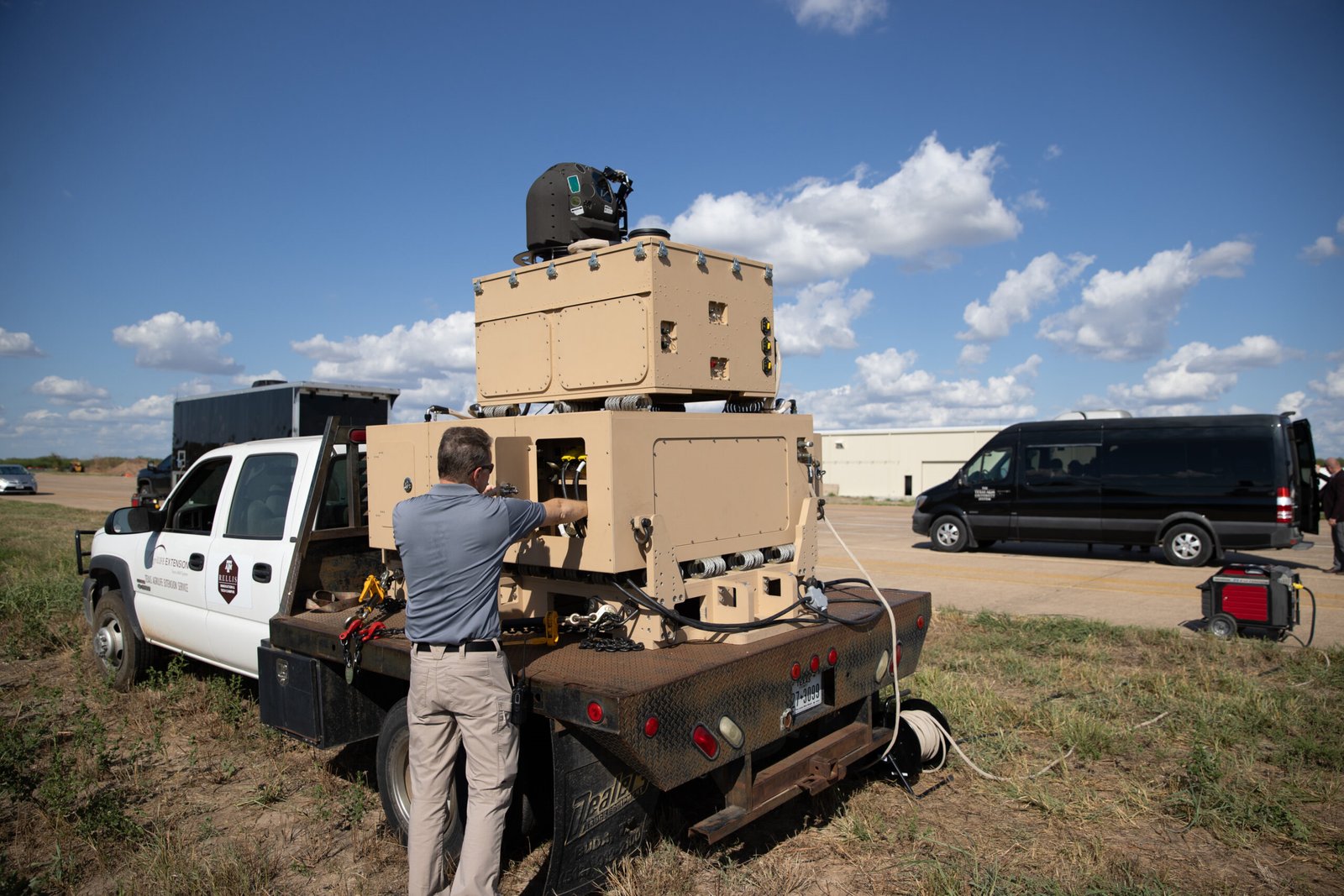On Sept. 21 and 22, Raytheon, an RTX company, conducted an open-air test of an operational laser weapon on the Texas A&M-RELLIS campus at the George H.W. Bush Combat Development Complex (BCDC). Raytheon’s high-energy lasers (HEL) are combat-ready weapons that use silent, invisible beams of light to destroy drone threats at great distances. The open-air test was the first such shot of a laser weapon in the State of Texas, creating a new capability to advance critical defense technologies.
“We see drone attacks having an out-sized impact in combat zones and even civilian settings, and they are extremely difficult to detect and defeat,” said Michael Hofle, senior director of high energy lasers at Raytheon. “That’s why we’re making Texas a hub for solving these challenges, side-by-side with the Bush Combat Development Complex. Our combat-ready laser weapons are a cheat code against drones. So, having the ability to test our systems in our own backyard is a game changer for getting this technology into the hands of uniformed personnel quickly and affordably.”
The 15-kilowatt laser weapon is the ninth Raytheon has produced in McKinney, Texas. Previous tests and demonstrations were conducted in other states where appropriate firing ranges already exist. With the successful test on the BCDC Innovation Proving Ground (IPG), Raytheon can now design, produce and test laser weapons in Texas.
“We are proud to collaborate with Raytheon on the latest technologies for national security,” said John Sharp, chancellor of The Texas A&M University System. “This is another example of the world-changing impact that Texas A&M-RELLIS will have for generations to come.”
The Raytheon test is an example of how the BCDC will help various customers accelerate innovative research and development on behalf of national security. The complex’s labs offer a wide array of capabilities for collaboration among the defense industry, universities, government and the tech sector.
A team of experts transported the laser weapon to the RELLIS campus for final adjustments, and the calibrations and tests performed on the laser weapon included tracking, targeting and destroying multiple drone targets while fine-tuning system parameters. The system will be shipped to the United Kingdom in October for final integration and delivery to the U.K. Ministry of Defense.
“When we met with Army Futures Command four years ago, they identified a need for our assistance in advancing their directed energy capabilities,” said BCDC director Tim Green. “Texas A&M System leadership then worked with the 2019 Texas legislature and the Board of Regents to obtain a combined $130 million toward the development of facilities here on Texas A&M-RELLIS, designed to accelerate the development of key national security technologies, including directed energy, at what is now known as BCDC. We are proud to bring together industry and academic experts, working closely together to provide a capability Texas needs to be a leader in delivering directed energy weapons to meet urgent military needs.”
When Raytheon representatives visited BCDC in February 2023, the BCDC team anticipated the primary discussion topic would be related to directed energy testing inside the Ballistic, Aero-optic and Materials (BAM) range, which is scheduled for completion in Spring 2024, and ongoing research at the Texas A&M Aerospace Laboratory for Lasers, ElectroMagnetics and Optics (ALLEMO). Following a full overview and tour, Raytheon officials saw an opportunity to test both weapon systems and potential platforms using the IPG, and they inquired about the ability to conduct open-air shots on the IPG.
Dr. James Creel, a BCDC-directed energy senior research engineer, served as lead for the project.
“When Raytheon asked about our ability to perform live-fire tests, it did catch us off guard. But when we saw how much of a game changer this could be for the State of Texas and for our troops, we quickly established a team of experts from across the Texas A&M University System, and other state agencies like the Texas Department of State Health Services, (DSHS) to quickly develop the capability where that kind of test could be conducted safely here on the Texas A&M-RELLIS campus,” said Creel. “We’re proud of the way this team came together to provide this new capability, and we’re excited to work with Raytheon to help them develop future capabilities.”
BCDC is in the process of establishing a more formal relationship with Raytheon over the coming months.
“This type of HEL testing and evaluation was previously considered impossible within Texas. I am so thankful to have partners from Raytheon, other state agencies, and many system organizations working together to solve problems and create capabilities here that will help make us more secure and protect our military personnel,” Green said. “Dr. Creel did a great job pulling together our system teammates from RELLIS administration, safety, the Texas A&M Experiment Station (TEES) and the IPG. Col. (U.S. Army, Ret) Brian McHugh’s excellence at range operations was critical to winning state approval for the permit. I see this as the beginning of several emerging partnerships, and I’m honored to be a part of it.”
Directed energy weapons are proving to be a critical need as the U.S. and partner nations work to develop counter-drone capabilities. Industry, government and academia are working diligently to deliver the technology to protect both our forces as well as the homeland.

